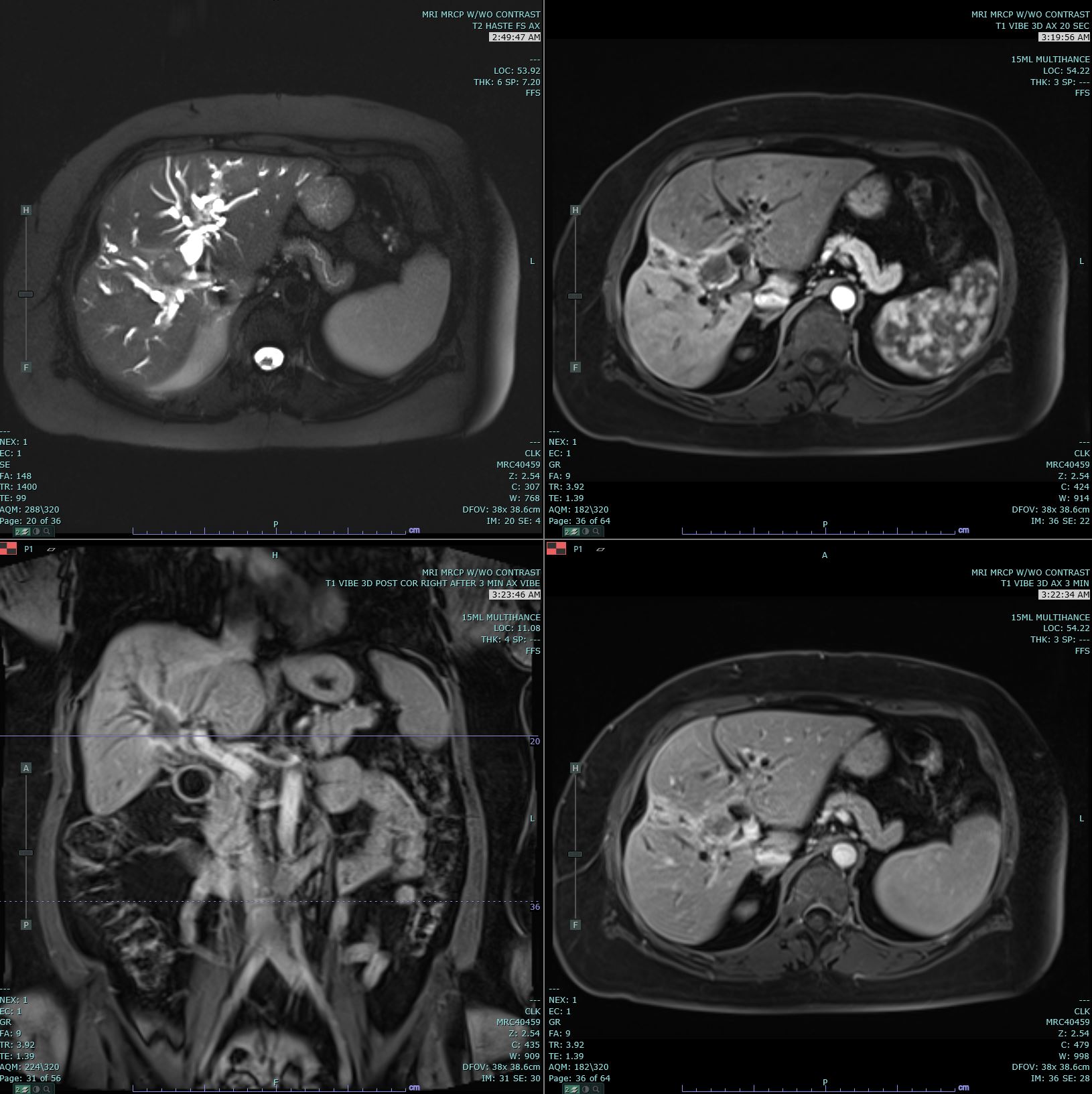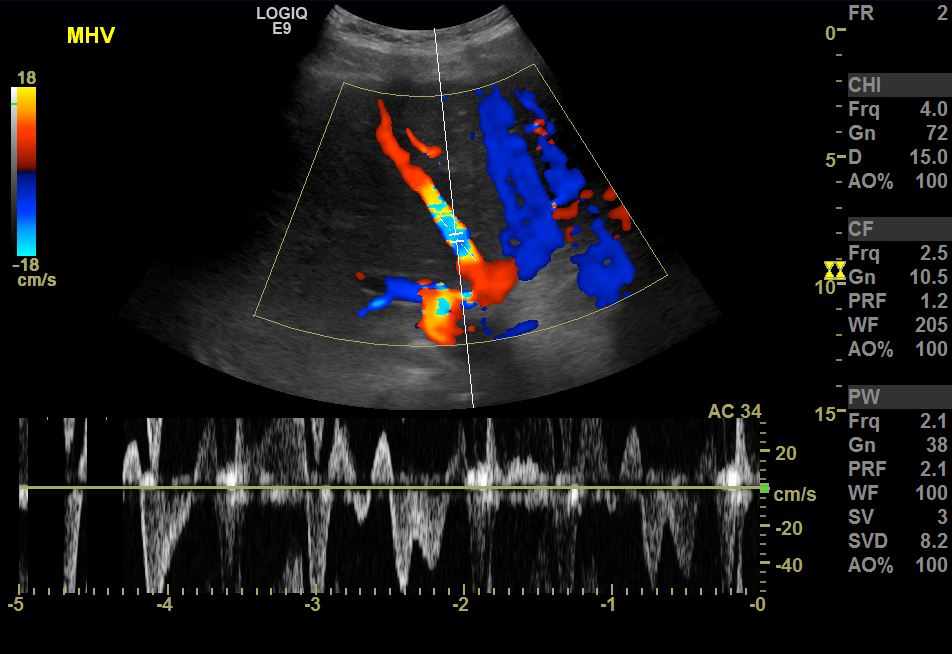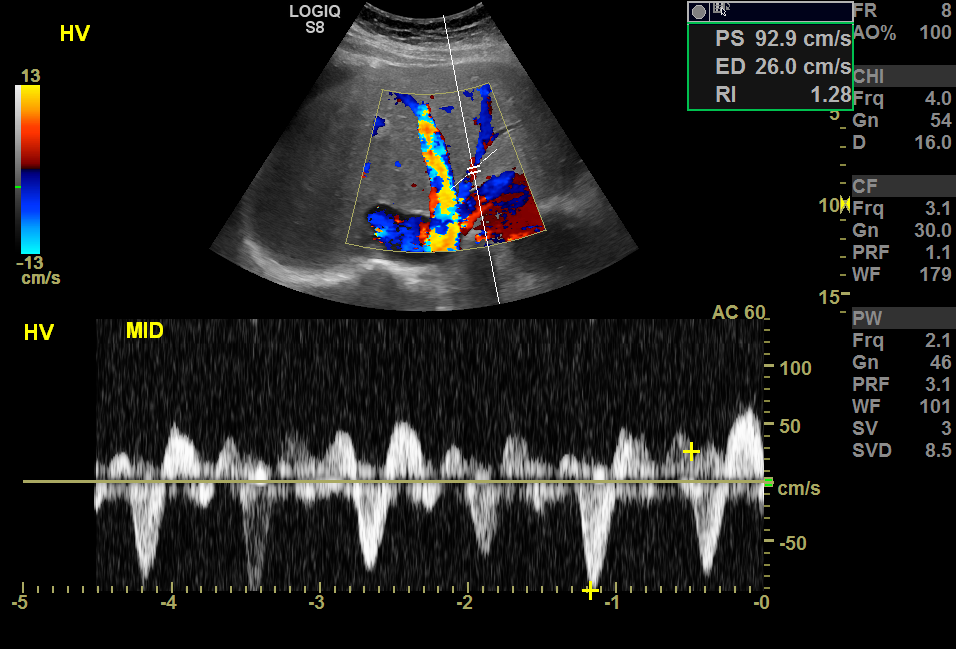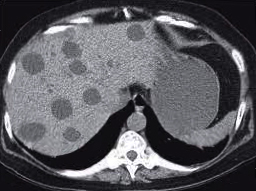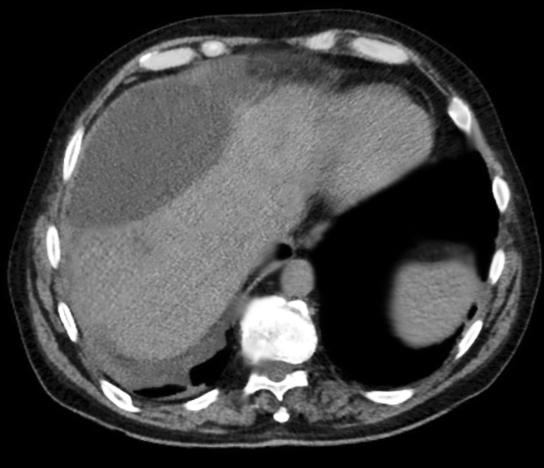[1]
Hultcrantz R,Glaumann H,Lindberg G,Nilsson LH, Liver investigation in 149 asymptomatic patients with moderately elevated activities of serum aminotransferases. Scandinavian journal of gastroenterology. 1986 Jan;
[PubMed PMID: 3952445]
[2]
Ioannou GN,Boyko EJ,Lee SP, The prevalence and predictors of elevated serum aminotransferase activity in the United States in 1999-2002. The American journal of gastroenterology. 2006 Jan;
[PubMed PMID: 16405537]
[3]
Tapper EB,Lok AS, Use of Liver Imaging and Biopsy in Clinical Practice. The New England journal of medicine. 2017 Aug 24;
[PubMed PMID: 28834467]
[4]
Maniam S,Szklaruk J, Magnetic resonance imaging: Review of imaging techniques and overview of liver imaging. World journal of radiology. 2010 Aug 28;
[PubMed PMID: 21160685]
Level 3 (low-level) evidence
[5]
Zhang YN,Fowler KJ,Hamilton G,Cui JY,Sy EZ,Balanay M,Hooker JC,Szeverenyi N,Sirlin CB, Liver fat imaging-a clinical overview of ultrasound, CT, and MR imaging. The British journal of radiology. 2018 Sep;
[PubMed PMID: 29722568]
Level 3 (low-level) evidence
[6]
Fasel JH,Majno PE,Peitgen HO, Liver segments: an anatomical rationale for explaining inconsistencies with Couinaud's eight-segment concept. Surgical and radiologic anatomy : SRA. 2010 Oct;
[PubMed PMID: 20111966]
[7]
Fischer L,Cardenas C,Thorn M,Benner A,Grenacher L,Vetter M,Lehnert T,Klar E,Meinzer HP,Lamadé W, Limits of Couinaud's liver segment classification: a quantitative computer-based three-dimensional analysis. Journal of computer assisted tomography. 2002 Nov-Dec;
[PubMed PMID: 12488744]
[8]
Lafortune M,Madore F,Patriquin H,Breton G, Segmental anatomy of the liver: a sonographic approach to the Couinaud nomenclature. Radiology. 1991 Nov;
[PubMed PMID: 1924786]
[9]
Pauli EM,Staveley-O'Carroll KF,Brock MV,Efron DT,Efron G, A handy tool to teach segmental liver anatomy to surgical trainees. Archives of surgery (Chicago, Ill. : 1960). 2012 Aug;
[PubMed PMID: 22911067]
[10]
Itoh S,Ikeda M,Achiwa M,Satake H,Iwano S,Ishigaki T, Late-arterial and portal-venous phase imaging of the liver with a multislice CT scanner in patients without circulatory disturbances: automatic bolus tracking or empirical scan delay? European radiology. 2004 Sep;
[PubMed PMID: 15067427]
[11]
Brancatelli G,Federle MP,Baron RL,Lagalla R,Midiri M,Vilgrain V, Arterially enhancing liver lesions: significance of sustained enhancement on hepatic venous and delayed phase with magnetic resonance imaging. Journal of computer assisted tomography. 2007 Jan-Feb;
[PubMed PMID: 17259843]
[12]
Rammohan A,Sathyanesan J,Ramaswami S,Lakshmanan A,Senthil-Kumar P,Srinivasan UP,Ramasamy R,Ravichandran P, Embolization of liver tumors: Past, present and future. World journal of radiology. 2012 Sep 28
[PubMed PMID: 23024842]
[14]
Schmidt S, Demartines N, Soler L, Schnyder P, Denys A. Portal vein normal anatomy and variants: implication for liver surgery and portal vein embolization. Seminars in interventional radiology. 2008 Jun:25(2):86-91. doi: 10.1055/s-2008-1076688. Epub
[PubMed PMID: 21326549]
[15]
Eipel C, Abshagen K, Vollmar B. Regulation of hepatic blood flow: the hepatic arterial buffer response revisited. World journal of gastroenterology. 2010 Dec 28:16(48):6046-57
[PubMed PMID: 21182219]
[16]
Miñano C,Garcia-Tsao G, Clinical pharmacology of portal hypertension. Gastroenterology clinics of North America. 2010 Sep;
[PubMed PMID: 20951924]
[17]
Kennedy P,Bane O,Hectors SJ,Fischman A,Schiano T,Lewis S,Taouli B, Noninvasive imaging assessment of portal hypertension. Abdominal radiology (New York). 2020 Nov;
[PubMed PMID: 32926209]
[18]
Naschitz JE,Slobodin G,Lewis RJ,Zuckerman E,Yeshurun D, Heart diseases affecting the liver and liver diseases affecting the heart. American heart journal. 2000 Jul;
[PubMed PMID: 10874271]
[19]
Wells ML,Fenstad ER,Poterucha JT,Hough DM,Young PM,Araoz PA,Ehman RL,Venkatesh SK, Imaging Findings of Congestive Hepatopathy. Radiographics : a review publication of the Radiological Society of North America, Inc. 2016 Jul-Aug;
[PubMed PMID: 27284758]
[20]
Afif AM,Chang JP,Wang YY,Lau SD,Deng F,Goh SY,Pwint MK,Ooi CC,Venkatanarasimha N,Lo RH, A sonographic Doppler study of the hepatic vein, portal vein and hepatic artery in liver cirrhosis: Correlation of hepatic hemodynamics with clinical Child Pugh score in Singapore. Ultrasound (Leeds, England). 2017 Nov;
[PubMed PMID: 29163657]
[21]
Desautels CN,Tierney DM,Rossi F,Rosborough TK, Case report: an unrecognized etiology of transient gallbladder pain in heart failure diagnosed with internist-performed point-of-care ultrasound. Critical ultrasound journal. 2015;
[PubMed PMID: 25852843]
Level 3 (low-level) evidence
[22]
Teefey SA,Baron RL,Bigler SA, Sonography of the gallbladder: significance of striated (layered) thickening of the gallbladder wall. AJR. American journal of roentgenology. 1991 May;
[PubMed PMID: 2017956]
[23]
Smith A,Baumgartner K,Bositis C, Cirrhosis: Diagnosis and Management. American family physician. 2019 Dec 15;
[PubMed PMID: 31845776]
[24]
Kartalis N,Brehmer K,Loizou L, Multi-detector CT: Liver protocol and recent developments. European journal of radiology. 2017 Dec
[PubMed PMID: 29153359]
[25]
Kim SH,Kamaya A,Willmann JK, CT perfusion of the liver: principles and applications in oncology. Radiology. 2014 Aug;
[PubMed PMID: 25058132]
[26]
Sween S,Samar C,Binu SM, Triple-phase MDCT of liver: Scan protocol modification to obtain optimal vascular and lesional contrast. The Indian journal of radiology & imaging. 2018 Jul-Sep
[PubMed PMID: 30319208]
[27]
Hennedige T,Venkatesh SK, Imaging of hepatocellular carcinoma: diagnosis, staging and treatment monitoring. Cancer imaging : the official publication of the International Cancer Imaging Society. 2013 Feb 8
[PubMed PMID: 23400006]
[28]
Kojiro M,Roskams T, Early hepatocellular carcinoma and dysplastic nodules. Seminars in liver disease. 2005;
[PubMed PMID: 15918142]
[29]
Ringe KI,Wacker F, Radiological diagnosis in cholangiocarcinoma: Application of computed tomography, magnetic resonance imaging, and positron emission tomography. Best practice
[PubMed PMID: 25966426]
[31]
Ahmed AM,Ebid ME,Ajlan AM,Al-Mallah MH, Low-dose attenuation correction in diagnosis of non-alcoholic fatty liver disease. Abdominal radiology (New York). 2017 Oct
[PubMed PMID: 28470401]
[32]
Hamer OW,Aguirre DA,Casola G,Lavine JE,Woenckhaus M,Sirlin CB, Fatty liver: imaging patterns and pitfalls. Radiographics : a review publication of the Radiological Society of North America, Inc. 2006 Nov-Dec
[PubMed PMID: 17102041]
[33]
Kalra N,Duseja A,Das A,Dhiman RK,Virmani V,Chawla Y,Singh P,Khandelwal N, Chemical shift magnetic resonance imaging is helpful in detecting hepatic steatosis but not fibrosis in patients with nonalcoholic fatty liver disease (NAFLD). Annals of hepatology. 2009 Jan-Mar;
[PubMed PMID: 19221529]
[34]
Taouli B,Ehman RL,Reeder SB, Advanced MRI methods for assessment of chronic liver disease. AJR. American journal of roentgenology. 2009 Jul;
[PubMed PMID: 19542391]
[35]
Yoshikawa J,Matsui O,Takashima T,Sugiura H,Katayama K,Nishida Y,Tsuji M, Focal fatty change of the liver adjacent to the falciform ligament: CT and sonographic findings in five surgically confirmed cases. AJR. American journal of roentgenology. 1987 Sep
[PubMed PMID: 3303875]
Level 3 (low-level) evidence
[36]
Décarie PO,Lepanto L,Billiard JS,Olivié D,Murphy-Lavallée J,Kauffmann C,Tang A, Fatty liver deposition and sparing: a pictorial review. Insights into imaging. 2011 Oct
[PubMed PMID: 22347973]
[37]
Bader TR,Braga L,Semelka RC, Exophytic benign tumors of the liver: appearance on MRI. Magnetic resonance imaging. 2001 Jun
[PubMed PMID: 11672619]
[38]
Özcan HN,Haliloğlu M,Sökmensüer C,Akata D,Özmen M,Karçaaltıncaba M, Imaging for abdominal involvement in amyloidosis. Diagnostic and interventional radiology (Ankara, Turkey). 2017 Jul-Aug;
[PubMed PMID: 28498108]
[39]
Schilsky ML. Wilson Disease: Diagnosis, Treatment, and Follow-up. Clinics in liver disease. 2017 Nov:21(4):755-767. doi: 10.1016/j.cld.2017.06.011. Epub 2017 Aug 10
[PubMed PMID: 28987261]
[40]
Cordella A,Bertolini G, Multiphase multidetector-row CT reveals different patterns of hepatic portal venous gas and pneumobilia. Veterinary radiology
[PubMed PMID: 33245597]
[41]
Abboud B,El Hachem J,Yazbeck T,Doumit C, Hepatic portal venous gas: physiopathology, etiology, prognosis and treatment. World journal of gastroenterology. 2009 Aug 7
[PubMed PMID: 19653334]
[43]
Khim G,Em S,Mo S,Townell N, Liver abscess: diagnostic and management issues found in the low resource setting. British medical bulletin. 2019 Dec 11
[PubMed PMID: 31836890]
[44]
Méndez RJ,Schiebler ML,Outwater EK,Kressel HY, Hepatic abscesses: MR imaging findings. Radiology. 1994 Feb;
[PubMed PMID: 8284394]
[45]
Mortelé KJ,Segatto E,Ros PR, The infected liver: radiologic-pathologic correlation. Radiographics : a review publication of the Radiological Society of North America, Inc. 2004 Jul-Aug;
[PubMed PMID: 15256619]
[46]
Masood A,Sallah S, Chronic disseminated candidiasis in patients with acute leukemia: emphasis on diagnostic definition and treatment. Leukemia research. 2005 May;
[PubMed PMID: 15755501]
[47]
Lima PH,Fan B,Bérubé J,Cerny M,Olivié D,Giard JM,Beauchemin C,Tang A, Cost-Utility Analysis of Imaging for Surveillance and Diagnosis of Hepatocellular Carcinoma. AJR. American journal of roentgenology. 2019 Jul
[PubMed PMID: 30995098]
[48]
Coenegrachts K, Magnetic resonance imaging of the liver: New imaging strategies for evaluating focal liver lesions. World journal of radiology. 2009 Dec 31
[PubMed PMID: 21160723]
[50]
Grazioli L,Bondioni MP,Haradome H,Motosugi U,Tinti R,Frittoli B,Gambarini S,Donato F,Colagrande S, Hepatocellular adenoma and focal nodular hyperplasia: value of gadoxetic acid-enhanced MR imaging in differential diagnosis. Radiology. 2012 Feb;
[PubMed PMID: 22282184]
[51]
Manduca A,Bayly PJ,Ehman RL,Kolipaka A,Royston TJ,Sack I,Sinkus R,Van Beers BE, MR elastography: Principles, guidelines, and terminology. Magnetic resonance in medicine. 2021 May;
[PubMed PMID: 33296103]
[52]
Shankaran K,Gill HH,Desai HG, Genetic hemochromatosis presenting as asymptomatic hepatomegaly. Indian journal of gastroenterology : official journal of the Indian Society of Gastroenterology. 1994 Apr
[PubMed PMID: 8206540]
[53]
Labranche R,Gilbert G,Cerny M,Vu KN,Soulières D,Olivié D,Billiard JS,Yokoo T,Tang A, Liver Iron Quantification with MR Imaging: A Primer for Radiologists. Radiographics : a review publication of the Radiological Society of North America, Inc. 2018 Mar-Apr
[PubMed PMID: 29528818]
[54]
Klotz T,Montoriol PF,Da Ines D,Petitcolin V,Joubert-Zakeyh J,Garcier JM, Hepatic haemangioma: common and uncommon imaging features. Diagnostic and interventional imaging. 2013 Sep
[PubMed PMID: 23796395]
[55]
Hoekstra LT,Bieze M,Erdogan D,Roelofs JJ,Beuers UH,van Gulik TM, Management of giant liver hemangiomas: an update. Expert review of gastroenterology
[PubMed PMID: 23445235]
[56]
Mamone G,Di Piazza A,Carollo V,Cannataci C,Cortis K,Bartolotta TV,Miraglia R, Imaging of hepatic hemangioma: from A to Z. Abdominal radiology (New York). 2020 Mar
[PubMed PMID: 31686179]
[57]
Hussain SM,Terkivatan T,Zondervan PE,Lanjouw E,de Rave S,Ijzermans JN,de Man RA, Focal nodular hyperplasia: findings at state-of-the-art MR imaging, US, CT, and pathologic analysis. Radiographics : a review publication of the Radiological Society of North America, Inc. 2004 Jan-Feb;
[PubMed PMID: 14730031]
[58]
Haring MPD,Gouw ASH,de Haas RJ,Cuperus FJC,de Jong KP,de Meijer VE, The effect of oral contraceptive pill cessation on hepatocellular adenoma diameter: A retrospective cohort study. Liver international : official journal of the International Association for the Study of the Liver. 2019 May
[PubMed PMID: 30773766]
Level 2 (mid-level) evidence
[60]
Micchelli ST,Vivekanandan P,Boitnott JK,Pawlik TM,Choti MA,Torbenson M, Malignant transformation of hepatic adenomas. Modern pathology : an official journal of the United States and Canadian Academy of Pathology, Inc. 2008 Apr;
[PubMed PMID: 18246041]
[61]
Nasser F,Affonso BB,Galastri FL,Odisio BC,Garcia RG, Minimally invasive treatment of hepatic adenoma in special cases. Einstein (Sao Paulo, Brazil). 2013 Dec;
[PubMed PMID: 24488396]
Level 3 (low-level) evidence
[62]
Seo JK,Kim SH,Lee SH,Park JK,Woo SM,Jeong JB,Hwang JH,Ryu JK,Kim JW,Jeong SH,Kim YT,Yoon YB,Lee KU,Kim SH,Kim MA, Appropriate diagnosis of biliary cystic tumors: comparison with atypical hepatic simple cysts. European journal of gastroenterology & hepatology. 2010 Aug
[PubMed PMID: 20300006]
[63]
Asuquo M,Nwagbara V,Agbor C,Otobo F,Omotoso A, Giant simple hepatic cyst: a case report and review of relevant literature. African health sciences. 2015 Mar
[PubMed PMID: 25834563]
Level 3 (low-level) evidence
[64]
Anderson MA,Dhami RS,Fadzen CM,Molina G,Taylor MS,Deshpande V,Qadan M,Catalano OA,Ferrone CR,Mojtahed A, CT and MRI features differentiating mucinous cystic neoplasms of the liver from pathologically simple cysts. Clinical imaging. 2021 Aug
[PubMed PMID: 33549919]
[65]
Mizejewski GJ, Levels of alpha-fetoprotein during pregnancy and early infancy in normal and disease states. Obstetrical
[PubMed PMID: 14668662]
[66]
Arrieta O,Cacho B,Morales-Espinosa D,Ruelas-Villavicencio A,Flores-Estrada D,Hernández-Pedro N, The progressive elevation of alpha fetoprotein for the diagnosis of hepatocellular carcinoma in patients with liver cirrhosis. BMC cancer. 2007 Feb 8
[PubMed PMID: 17288606]
[67]
Numata K,Luo W,Morimoto M,Kondo M,Kunishi Y,Sasaki T,Nozaki A,Tanaka K, Contrast enhanced ultrasound of hepatocellular carcinoma. World journal of radiology. 2010 Feb 28;
[PubMed PMID: 21160920]
[68]
Gupta P,Soundararajan R,Patel A,Kumar-M P,Sharma V,Kalra N, Abbreviated MRI for hepatocellular carcinoma screening: A systematic review and meta-analysis. Journal of hepatology. 2021 Jul
[PubMed PMID: 33548385]
Level 1 (high-level) evidence
[69]
Takayasu K,Furukawa H,Wakao F,Muramatsu Y,Abe H,Terauchi T,Winter TC 3rd,Sakamoto M,Hirohashi S, CT diagnosis of early hepatocellular carcinoma: sensitivity, findings, and CT-pathologic correlation. AJR. American journal of roentgenology. 1995 Apr
[PubMed PMID: 7726041]
[70]
Willatt JM,Hussain HK,Adusumilli S,Marrero JA, MR Imaging of hepatocellular carcinoma in the cirrhotic liver: challenges and controversies. Radiology. 2008 May;
[PubMed PMID: 18430871]
[71]
Bolog N,Andreisek G,Oancea I,Mangrau A, CT and MR imaging of hepatocellular carcinoma. Journal of gastrointestinal and liver diseases : JGLD. 2011 Jun;
[PubMed PMID: 21725516]
[72]
Ganeshan D,Szklaruk J,Kundra V,Kaseb A,Rashid A,Elsayes KM, Imaging features of fibrolamellar hepatocellular carcinoma. AJR. American journal of roentgenology. 2014 Mar;
[PubMed PMID: 24555590]
[73]
Namasivayam S,Martin DR,Saini S, Imaging of liver metastases: MRI. Cancer imaging : the official publication of the International Cancer Imaging Society. 2007;
[PubMed PMID: 17293303]
[74]
Phisalprapa P,Supakankunti S,Charatcharoenwitthaya P,Apisarnthanarak P,Charoensak A,Washirasaksiri C,Srivanichakorn W,Chaiyakunapruk N, Cost-effectiveness analysis of ultrasonography screening for nonalcoholic fatty liver disease in metabolic syndrome patients. Medicine. 2017 Apr
[PubMed PMID: 28445256]
[75]
Minami Y,Kudo M, Hepatic malignancies: Correlation between sonographic findings and pathological features. World journal of radiology. 2010 Jul 28;
[PubMed PMID: 21160664]
[76]
Bekker J,Ploem S,de Jong KP, Early hepatic artery thrombosis after liver transplantation: a systematic review of the incidence, outcome and risk factors. American journal of transplantation : official journal of the American Society of Transplantation and the American Society of Transplant Surgeons. 2009 Apr
[PubMed PMID: 19298450]
Level 1 (high-level) evidence
[77]
Strobel D,Seitz K,Blank W,Schuler A,Dietrich C,von Herbay A,Friedrich-Rust M,Kunze G,Becker D,Will U,Kratzer W,Albert FW,Pachmann C,Dirks K,Strunk H,Greis C,Bernatik T, Contrast-enhanced ultrasound for the characterization of focal liver lesions--diagnostic accuracy in clinical practice (DEGUM multicenter trial). Ultraschall in der Medizin (Stuttgart, Germany : 1980). 2008 Oct
[PubMed PMID: 19241506]
Level 1 (high-level) evidence
[78]
Battaglia V,Cervelli R, Liver investigations: Updating on US technique and contrast-enhanced ultrasound (CEUS). European journal of radiology. 2017 Nov
[PubMed PMID: 29103478]
[79]
Vijayaraghavan GR,David S,Bermudez-Allende M,Sarwat H, Imaging-guided Parenchymal Liver Biopsy: How We Do It. Journal of clinical imaging science. 2011
[PubMed PMID: 21966627]
[80]
Adnan A,Sheth RA, Image-guided Percutaneous Biopsy of the Liver. Techniques in vascular and interventional radiology. 2021 Dec;
[PubMed PMID: 34895710]
[81]
Smith BC,Desmond PV, Outpatient liver biopsy using ultrasound guidance and the Biopty gun is safe and cost effective. Australian and New Zealand journal of medicine. 1995 Jun;
[PubMed PMID: 7487687]
[82]
[Study of insulin receptors on liver and hepatoma cell plasma membranes]., Shelepov VP,Davydova SIa,Shapot VS,, Biokhimiia (Moscow, Russia), 1978 Mar
[PubMed PMID: 29334698]
[83]
[Redox potentials of some metalloproteins]., Makovkina LE,Mestechkina NM,Kuzhetsov EA,Mytuskii AA,Pshenova KV,, Biokhimiia (Moscow, Russia), 1978 Mar
[PubMed PMID: 29461949]
[84]
Simonovský V, The diagnosis of cirrhosis by high resolution ultrasound of the liver surface. The British journal of radiology. 1999 Jan
[PubMed PMID: 10341686]
[85]
Wernecke K,Henke L,Vassallo P,von Bassewitz DB,Diederich S,Peters PE,Edel G, Pathologic explanation for hypoechoic halo seen on sonograms of malignant liver tumors: an in vitro correlative study. AJR. American journal of roentgenology. 1992 Nov
[PubMed PMID: 1329455]
[86]
Dănilă M,Popescu A,Sirli R,Sporea I,Martie A,Sendroiu M, Contrast enhanced ultrasound (CEUS) in the evaluation of liver metastases. Medical ultrasonography. 2010 Sep
[PubMed PMID: 21203602]
[87]
Stange BJ,Glanemann M,Nuessler NC,Settmacher U,Steinmüller T,Neuhaus P, Hepatic artery thrombosis after adult liver transplantation. Liver transplantation : official publication of the American Association for the Study of Liver Diseases and the International Liver Transplantation Society. 2003 Jun;
[PubMed PMID: 12783404]
[88]
García-Criado A,Gilabert R,Salmerón JM,Nicolau C,Vilana R,Bianchi L,Buñesch L,García-Valdecasas JC,Rimola A,Brú C, Significance of and contributing factors for a high resistive index on Doppler sonography of the hepatic artery immediately after surgery: prognostic implications for liver transplant recipients. AJR. American journal of roentgenology. 2003 Sep
[PubMed PMID: 12933490]
[89]
Bajenaru N,Balaban V,Săvulescu F,Campeanu I,Patrascu T, Hepatic hemangioma -review-. Journal of medicine and life. 2015;
[PubMed PMID: 26361504]
[90]
Ito H,Tsujimoto F,Nakajima Y,Igarashi G,Okamura T,Sakurai M,Nobuoka S,Otsubo T, Sonographic characterization of 271 hepatic hemangiomas with typical appearance on CT imaging. Journal of medical ultrasonics (2001). 2012 Apr
[PubMed PMID: 27278845]
[91]
Park SJ,Kim JD,Seo YS,Park BJ,Kim MJ,Um SH,Kim CH,Yim HJ,Baik SK,Jung JY,Keum B,Jeen YT,Lee HS,Chun HJ,Kim CD,Ryu HS, Computed tomography findings for predicting severe acute hepatitis with prolonged cholestasis. World journal of gastroenterology. 2013 Apr 28
[PubMed PMID: 23674857]
[92]
Blechacz B,Gores GJ, Positron emission tomography scan for a hepatic mass. Hepatology (Baltimore, Md.). 2010 Dec
[PubMed PMID: 20967825]
[93]
Eo JS,Paeng JC,Lee DS, Nuclear imaging for functional evaluation and theragnosis in liver malignancy and transplantation. World journal of gastroenterology. 2014 May 14;
[PubMed PMID: 24833867]
[94]
Price M,Patino M,Sahani D, Computed Tomography Angiography of the Hepatic, Pancreatic, and Splenic Circulation. Radiologic clinics of North America. 2016 Jan;
[PubMed PMID: 26654391]
[95]
Raoul JL,Forner A,Bolondi L,Cheung TT,Kloeckner R,de Baere T, Updated use of TACE for hepatocellular carcinoma treatment: How and when to use it based on clinical evidence. Cancer treatment reviews. 2019 Jan;
[PubMed PMID: 30447470]
[96]
Kruskal JB,Newman PA,Sammons LG,Kane RA, Optimizing Doppler and color flow US: application to hepatic sonography. Radiographics : a review publication of the Radiological Society of North America, Inc. 2004 May-Jun;
[PubMed PMID: 15143220]
[97]
Talwalkar JA,Kurtz DM,Schoenleber SJ,West CP,Montori VM, Ultrasound-based transient elastography for the detection of hepatic fibrosis: systematic review and meta-analysis. Clinical gastroenterology and hepatology : the official clinical practice journal of the American Gastroenterological Association. 2007 Oct;
[PubMed PMID: 17916549]
Level 1 (high-level) evidence
[98]
Chernyak V,Fowler KJ,Kamaya A,Kielar AZ,Elsayes KM,Bashir MR,Kono Y,Do RK,Mitchell DG,Singal AG,Tang A,Sirlin CB, Liver Imaging Reporting and Data System (LI-RADS) Version 2018: Imaging of Hepatocellular Carcinoma in At-Risk Patients. Radiology. 2018 Dec
[PubMed PMID: 30251931]

